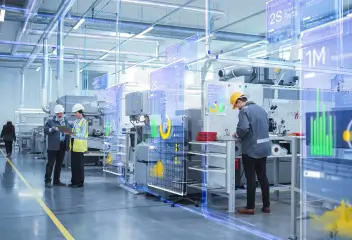Machine Learning Consulting and Solution Services
Consult with our Machine Learning experts and utilize the power of purpose-built machine learning solutions to transform business processes and solve real-world problems.
What's so Unique About Our Machine Learning Development Services?
Our machine learning experts leverage advanced statistical methods and deep knowledge of ML algorithms, including Deep Learning, to create customized solutions that meet the unique needs of your business. Build solutions that guarantee growth with our machine learning consulting services.

Our Machine Learning Solutions and Consulting Services Include

ML Consultation
Talk to Our ML experts with our machine learning consultation services. We provide everything from evaluating your data, and selecting the best ML approach to maximize ROI, to scoping, proving, and constructing user-facing prototypes.

Computer Vision
Utilize computer vision techniques to extract meaningful data from pictures and the surroundings for face recognition, biometrics, transportation, and other use cases.

ML Integration
Our expert ML engineers seamlessly integrate neural networks and other ML algorithms into your business application, enterprise system, or workflow. Leverage our expertise in deploying ML capabilities to revolutionize experiences and enhance operations.

ML Staff Augmentation
Find the best machine learning engineers to handle your AI and ML needs. Thanks to the flexible engagement and quick resource allocation choices, we can provide you with the agility you want when selecting a technology partner.

Anomaly Detection
Leverage data to recognize unusual activity to spot fraud, security flaws, data breaches, health issues, structural problems, etc. and take timely action.

Custom Development
With our Machine Learning as a service platform, we offer our clients the opportunity to create tailored machine learning applications.

NLP
Create chatbots, teach machines to interpret voice and text as people do, extract useful information, identify topics in text documents, and more.

Predictive Analytics
Utilize data from the past and present to get a glimpse into the future. Eliminate speculation and discover how the future will affect your business, clients, or the whole sector.
How We Build Machine Learning Solutions
Using an enhanced understanding of customer needs and alignment of end goals, Folio3 has built and deployed successful Machine Learning solutions. We deliver a rich user experience by encouraging regular touchpoints with customers and relevant stakeholders. Our development approach is tailored to your unique business needs:
01

Submission of a hypothesis
02

Scope and feasibility of the project with defined Delivery of a Proof of Concept
03

Algorithm development with regular touchpoints
04

Final delivery and live deployment
Utilize Folio3 Machine Learning as a Service Offering for Max Control Over Your ML Operations
Folio3’s Machine Learning as a service offers features that help automate model generation and tuning to increase efficiency and accuracy, deploying better and faster models in the cloud or on-premises. Extensive model testing and customization ensure the best solution fit for your company, as our experts collaborate with you throughout every step of the process, from data preparation to model training and evaluation to deployment.

ML Ops

Custom ML Development

Business Process Automation
Our ML development tech stack
Algorithms
Supervised Learning (classification, regression, etc.) | Semi-supervised Learning | Unsupervised Learning (clustering, etc.) | Deep Learning (neural networks, reinforcement learning, etc.) | Optimization | Probabilistic ML | Computer Vision (object detection, instance segmentation, etc) | other
Languages
Python | R | Scala | SQL | C++ | other
ML frameworks
TensorFlow | Scikit-learn | SciPy | PyTorch | other
Visualization
Power BI | Tableau | Qlik | Matplotlib | seaborn | ggplot2 | Plotly | Bokeh
DBMS
MS SQL | PostgreSQL | MySQL | MongoDB | CouchDB | Cassandra | Hadoop | other
Cloud Platforms
Amazon Web Services | Google Cloud Platform | Microsoft Azure
Why Choose Folio3?
We offer tailored solutions for our clients with the flexibility that they need to stay competitive in their respective industries. Our experience of working in different verticals gives us an insight into business-specific tech solutions. Hire Machine learning experts on an hourly or full-time basis and save development costs.

Hassle-Free Project
Management

Full
Visibility

Extensive
Experience

Integrity and
Transparency

18+ Years of
Experience

Flexible Engagement
Models
What We Do Right
Through the use of the latest technologies, we can help you maximize efficiency and productivity by automating your transcription process. This can provide multiple benefits to both individuals and corporations.

Provide Technical Expertise
Build robust solutions to ensure sustainable growth in the digital economy

Deliver the Best Solution
Smooth deployment in the best possible manner at the best price points

Feature Rich Solutions
Maintain an enriched ecosystem for guidance to increase efficiency

Build ML Apps with Ease
With our Machine Learning as a service platform, we offer our clients the opportunity to create tailored machine learning applications
Machine Learning FAQs
What is a kernel in machine learning as a service?
In machine learning, a “kernel” refers to the method of using a linear classifier to solve a non-linear problem. It requires changing linearly inseparable data into linearly separable ones. The kernel function allows mapping of non-linear observations into a higher-dimensional space, facilitating separability. The kernel approach is simply a framework for performing pattern analysis on different types of data across a series of tasks for a range of applications. It also facilitates the use of feature spaces, where parameter dimensionality is more than polynomial.
In computing, the kernel computer program is at the core of a computer’s operating system, with unrestricted control over the entire system. It is usually one of the first programs to load on start-up before the boot loader.
What is bias in machine learning as a service?
Machine Learning algorithms are designed utilizing data that is trained to make assumptions. The machine learning model uses new data input to generate values based on trained machine learning model. The data remain dependant on the set of training data that is used for scoring. Scoring is basically prediction and if not properly monitored can become susceptible to cognitive biases. Assumptions can be biased and in Machine Learning it helps generalize data so that better results can be formulated for larger datasets with various other attributes. Bias in Machine Learning helps make models less sensitive to single data point, however generalized algorithms can also produce outcomes that are systematically prejudiced. When it comes to crucial decisions, bias in Machine Learning can produce amplified results that may not provide a true picture of ground reality.
What is cross validation in machine learning?
This procedure of choosing the numerical outcomes measuring hypothesized connections between factors, are adequate as descriptions of the data, is known as validation. As an acceptable practice, an error estimation for the model is made in the wake of preparing, also called evaluation of residuals. A training error procedure would produce the estimated difference in the predicted and actual responses. Be that as it may, this procedure just gives an idea regarding how well our model does on data used to train it; giving two possible outcomes for the model, either underfitting or overfitting the data. Along these lines, the issue with this assessment procedure is that it doesn't give an indication of how well the learner will sum up to an independent/ unseen data set. Arriving at the conclusion is known as Cross Validation.
What is a classifier in machine learning as a service?
The procedure of predicting the class of given data points is known as classification. Terms such as labels or categories are interchangeably used for classes. Classification predictive modeling is a process of approximating a mapping function, from input variables to make output variables distinct.
Classification comes under supervised learning where the targets also input data. Classification applications are available across multiple domains such as in credit approval and medical diagnosis. Supervised learning procedures can broadly be divided into regression and classification algorithms. Classification algorithms in Machine Learning include Logistic Regression, Decision Tree, Random Forest and Naive Bayes.









